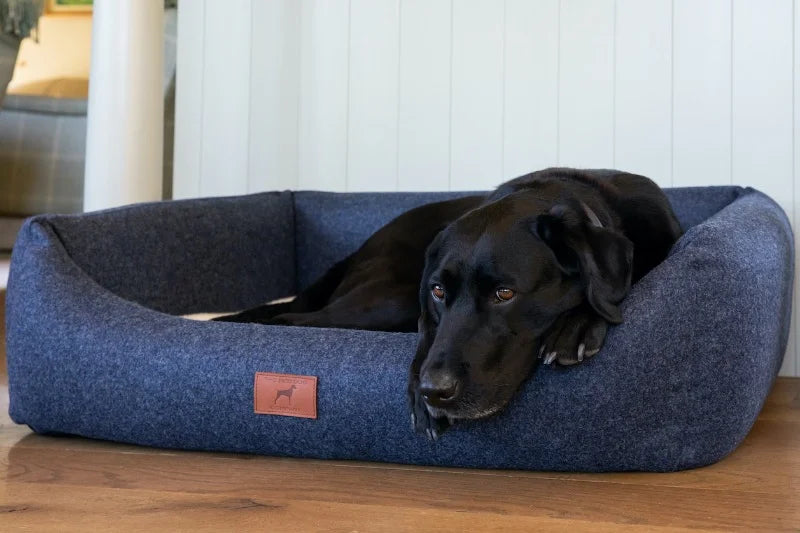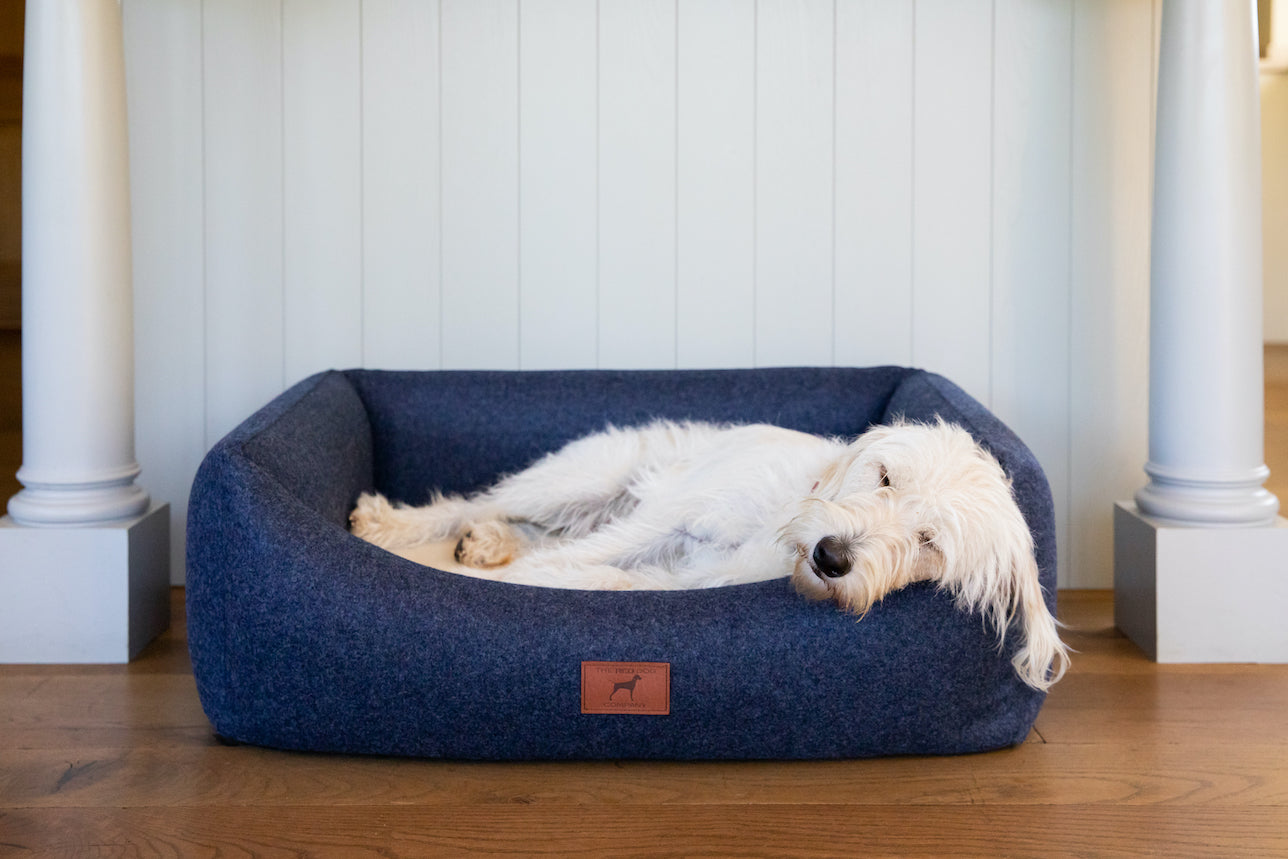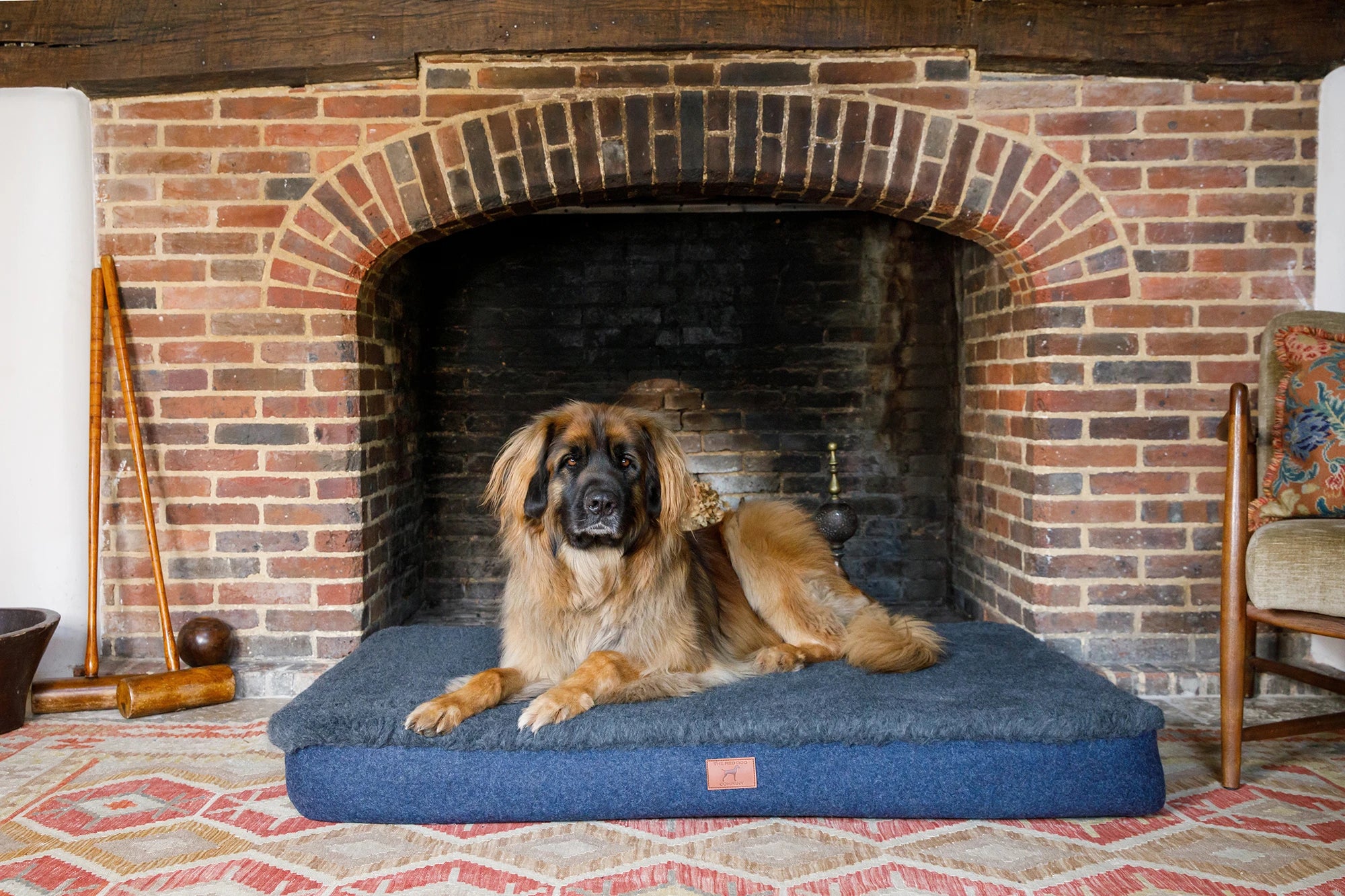Beds, Mats and Roll Mats for Labradors
Smaller bitches may fit in to our Medium sized Beds but larger bitches and males will be more comfortable with a Large Beds. Our Large Mats will give them space to stretch out, if that’s how they prefer to rest.
Each of our Beds and Mats has an orthopaedic mattress. The memory foam mattress upper moulds to your dog. This gives support and comfort, whilst the high density foam element of the mattress ensures your dog has ongoing support and does not sink to the floor. Each mattress has a waterproof cover to minimise mattress damage and every outer mattress cover is machine washable.
The mattress cover has a sheepskin fleece topper, either natural or grey, and an attractive yet hard wearing wool tweed is used for the surrounds. The base of the Beds and Mats is made from a very tough, water resistant material.
The extensive use of wool provides a hypoallergenic, warm, odour resistant and moisture wicking environment for your Labrador to sleep in.
We run a bespoke service for the Mats, so that you can have a mat that fits perfectly in to the car, a crate or cubby hole at home. We recognise that a Red Dog Company bed is an investment and we want your dog to enjoy it for a long period of time, so we offer a repair service and sell spare covers for the Mat and Bed - both the mattress and rest of bed.
In addition to the Mats and Beds, we have produced the space-saving, attractive Roll Mats for dogs on the go. These are perfect for in the car, in a restaurant or to cover a chair but would not be advised for long term use for dogs with arthritis. Again, made using British wool fleece and British tweed these roll mats provide a cosy place to rest but do not have a mattress for joint support and ultimate comfort.
All elements of the Beds, Mats and Roll mats are UK produced and assembled in the factory in Swadlincote. We have a strict quality control process and take great pride in our beds, that’s why we offer you a Satisfaction Guarantee. We only want delighted customers and comfortable dogs.

Britain’s Most Popular Breed
The Royal Veterinary College (RVC) currently estimates there to be more than one million Labradors in the UK and according to the Kennel Club, last year, the Labrador was Britain’s most popular breed.
What are the Origins of the Labrador?
The Labrador retriever originates from Newfoundland in Canada where, form the sixteenth century, dogs were used to help fishermen in their net collecting and lost line retrieving duties as well as to pull fish-laden carts. These dogs were smaller in stature than the Labradors we recognise in the UK today and it is thought that these smaller St John’s dog variety were crossed with larger hunting dogs taken to Newfoundland by the British. Some of these crosses were brought back to England where their gentle nature and retrieving ability were celebrated by the sporting gentry. The Second Earl of Malmesbury took a particular interest in these dogs, he had the first kennel of Labradors and bred them for waterfowling.
Versatility of the Labrador
The Labrador has proved to be a great choice for many families in the UK; as well as being a working gundog breed; used widely as Guide Dogs; in the Services for drug and explosive detection and in Search and Rescue.
Characteristics of the Labrador
The breed is described as being strong in general appearance with a broad and deep chest, broad hindquarters and broad skull with a wide nose and well developed nostrils. These good tempered dogs are intelligent, biddable and keen to please (as well as being keen to swim!)
The Kennel Club states that the ideal height at the withers for a dog is 56-57cm and 55-56cm for the bitch. The Labrador Retriever Club suggests ideal weights for working Labradors of 29.5Kg - 36Kg for dogs and 25Kg - 34Kg for bitches. Labradors are considered to be a medium-sized breed but due to their strong and sturdy build, they can seem much larger.
Arthritis and the Labrador
Labradors as a breed are over represented in the developmental diseases of elbow and hip dysplasia and unfortunately, as detailed below, Labradors are more prone to arthritis than the non Labrador breeds. Providing arthritic dogs with a suitable bed that supports their inflamed joints is a very important part of managing this painful, progressive disease.
General Health of Labradors
The key findings were that Labradors had a significantly increased risk of :
Fatty lumps (x2.5)
Kennel cough (x2.3)
Laceration (x2.2)
Moist dermatitis (x1.7), Ear infection (x1.5)
Obesity (x1.6)
Diarrhoea (x1.4)
Labradors had a significantly decreased risk of:
Heart murmur (x0.2)
Flea infestation (x0.2)
Dental disease (x0.4), Retained deciduous teeth (x0.3)
Aggression (x0.4)
Anal gland impact ion (x0.7)
Responsible Labrador breeding
Responsible breeders use DNA tests, screening schemes and inbreeding coefficient calculators in their aim to breed the healthiest pups possible. As with many breeds, Labradors can suffer with hereditary eye disorders, hip dysphasia and elbow dysplasia so members of Kennel Club’s Assured Breeders will, as a minimum, use the KC/BVA Hip Dysplasia Screening Scheme, Elbow Dysplasia Screening Scheme and the Eye Screening Scheme.



